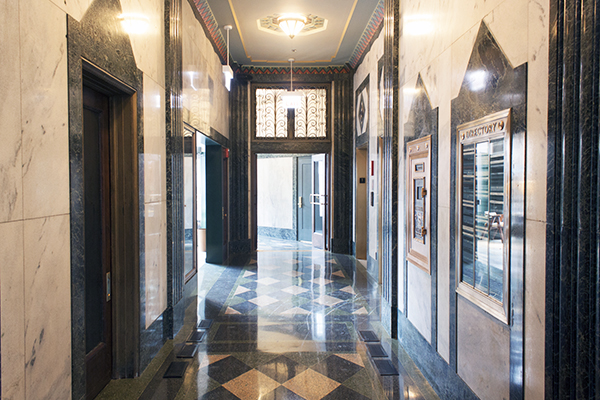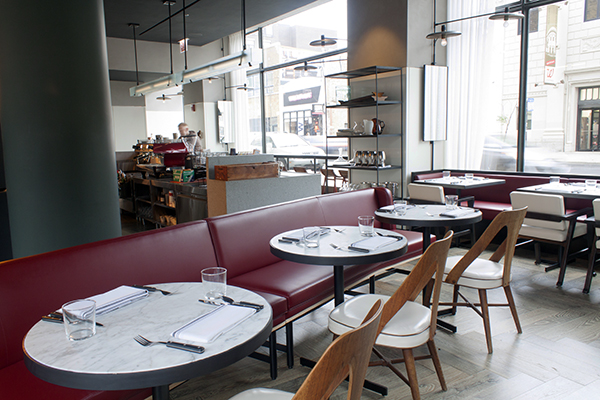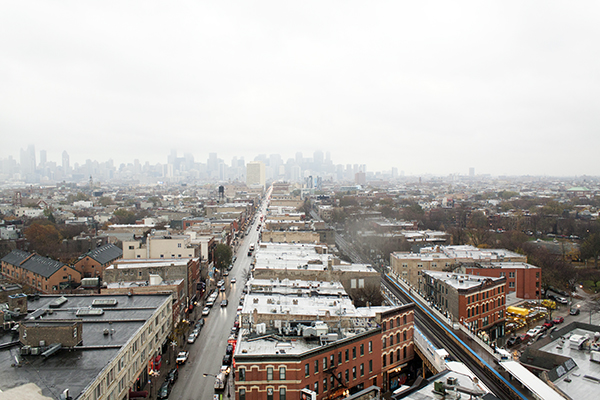Standing outside the old Northwest Tower at the six-corner intersection of Damen, Milwaukee, and North Avenues, I took in a view I had seen hundreds of times before. But something was different and I could feel it as I turned back to look at the 1929 art deco building, which opens this Wednesday as the 69-room Robey hotel (2018 W. North Ave.).
I was here for a tour with Carlos Couturier, a founding partner of the Mexico-based Grupo Habita that will operate the new Chicago hotel and the neighboring Hollander hostel (2022 W. North Ave.), also opening on Wednesday. We looked up at the 12-story landmark. More restoration was still in store for the exterior, and yet this once-deteriorating office building felt newly relevant and imposing, its apex jutting into the confluence of Wicker Park and Bucktown like the bow of a new ocean liner.
Couturier brought us here to start because, as he explained, location is everything: “We like to be the first to go to a neighborhood, where no one else has really gone.”
For more photos, see full gallery below.
The Robey
Design
In many ways, the Robey goes where no hotel in Chicago has gone before. Not only to this electric intersection and these neighborhoods, which have sorely needed a unique hotel of their own. But also with a design-forward agenda that maps to the mood and style of the locale. It’s something you see straightaway in the lobby, where restored features—like decorative brass elevator doors and geometric marble inlay designs—contrast with mod additions, like the boxy metal reception desk.

Public Spaces
From there, Couturier ushered me through the hotel’s easygoing public spaces, including the street-level Café Robey with its open kitchen (try the grilled Spanish octopus) and the more subdued second-floor lounge, which is outfitted with reclaimed retro furniture from local shops like Salvage One. Both floors reflect a smart design that blends thoughtfully with the scene just outside the door. “You are so in contact with the energy of the intersection and also it feels very private,” he said, waving me over to a window. “Look how close you are.”

Rooftop
As with most hotel rooftops, the Robey’s Up & Up terrace is a showstopper. But the view is different from its downtown counterparts. At night, Milwaukee Avenue and the L track that runs parallel to it illuminate like the lights of an airplane landing strip, leading your eyes straight into the Chicago skyline; by day, the same view expands to include the backdrop of Lake Michigan. I was a bit in awe. “People who come here from Chicago are impressed,” Couturier said. “It is a view they never get to see.”
The entire rooftop is sleek, intimate, and warm. A glass-enclosed indoor lounge at the center includes a small retro bar that seats four, surrounded by a wide, wrap-around exterior deck. Closer to the front of the building is a lantern-style cupola, its exterior adorned with art deco-inspired features and statues. Below the cupola, a tiny room with ornamental amber lights and cushioned benches is available for tiny private parties. All together, the space accommodates around 80 people.
The catch: this rooftop is exclusively available to Robey guests and their friends. Couturier explained that they don’t want it to feel crowded or loud with a queue out the front door, nor did they want it to be a members-only space. Up & Up will take names and numbers so that guests won’t have to wait in line.

The idea that it’s exclusive may rub locals the wrong way, but perhaps not for long: Come spring, the hotel plans to unveil the sixth-story Cabana Club, a rooftop restaurant that will be open to the public. (The Cabana Club will also feature a pool, but that pool is for Robey and Hollander guests only.)
Rooms
We ventured down a couple floors to check out the Robey’s rooms, where a comfortable mid-century modern style prevails (from $135). “The inspiration for this hotel is a bit of Edward Hopper and that all-American experience,” said Couturier. You see it in retro phones on marble-and-wood bedside tables, simple bathrooms that lend a glossy masculine feel, and lighting that plays out in everything from textured glass walls to dimmable controlled lights over cozy seating nooks.
Huge, double-pane windows keep the noise of the L to a minimum and the street scene below at an almost magical distance. Yet even with their warm and comfortable design, rooms are almost minimalist to a fault; none—not even its best Panorama Suite—are available with a tub, a shower door instead of a curtain, or even two beds.

The Hollander
Design
Couturier’s answer to a room with more beds: the adjacent 20-room Hollander hostel. Set in a revamped 1905 warehouse, the new hostel offers eight shared rooms for up to six guests and 12 private rooms for two to four guests (from $45 a bed or $125 for a private room).
The property reflects a recent trend in robust and lively hostels geared toward millennials who want to socialize, such as Chicago's Freehand. The Hollander aims to take it a step further with a social media experience that invites guests to engage and connect via Instagram before they arrive. The thinking is that guests might connect with other like-minded guests and even bunk up in shared rooms together. “We want to make it a social stay,” said Couturier. “Kind of like when you book Uber pool and share a ride, only we’re doing it in hospitality. We call it ‘social media meets social stay.’”
Public Spaces
The physical side of the stay starts in the Hollander’s ground-floor lobby, with a catch-all public space that includes a café (think: croissants and OJ) by day, a bar (hot dogs, bottled cocktails, and canned beers) by night. The large white space with low-slung seating also includes a bike rental and repair shop, a reception desk, laundry machines behind a glass wall, and lockers.
The building’s warehouse bones are embraced under tall ceilings with exposed ductwork and large cement pillars wrapped in black-leather banquettes.
.jpg)
Rooms
The hostel’s shared rooms feature six beds, each wrapped in a blond wood frame with its own light fixture, towel, and blanket. The ceilings are tall and exposed, and the Damen Blue Line stop is in plain view outside the window. At the room’s entrance, individual lockers face bathroom areas with open vanities, a private toilet, and a private shower and changing room. “This is a real social hostel experience,” said Couturier. “You have to like the people who are staying with you.”
For those not game to share, 12 private rooms offer an assortment of sleep arrangements that include a double bed plus one or two bunks. These rooms also feature a TV and refrigerator, and sometimes a desk or sitting area.

I asked Couturier why a solo guest or a couple would choose a private room at a hostel when they could spend a little more for a real-deal private hotel room at the Robey. He brought it back to design and sensibility, and the idea that socializing is part of a bigger story: “If I were to say one thing about both properties, I would say the Robey is bringing the past to the present, while the Hollander is bringing the present to the future.”


